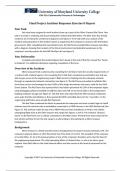Exam (elaborations)
CSIA 310: Cybersecurity Processes & Technologies | Final Project:Incident Response Exercise & Report
CSIA 310: Cybersecurity Processes & Technologies | Final Project:Incident Response Exercise & Report
[Show more]
Preview 2 out of 11 pages
Uploaded on
April 17, 2024
Number of pages
11
Written in
2023/2024
Type
Exam (elaborations)
Contains
Questions & answers
$10.49
100% satisfaction guarantee
Immediately available after payment
Both online and in PDF
No strings attached
CSIA 310: Cybersecurity Processes & Technologies




